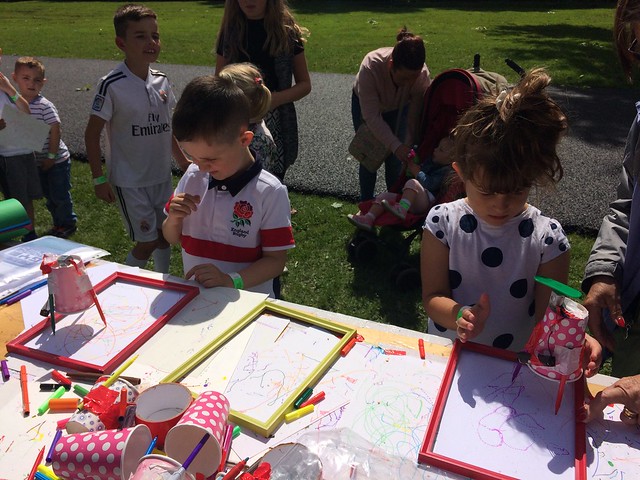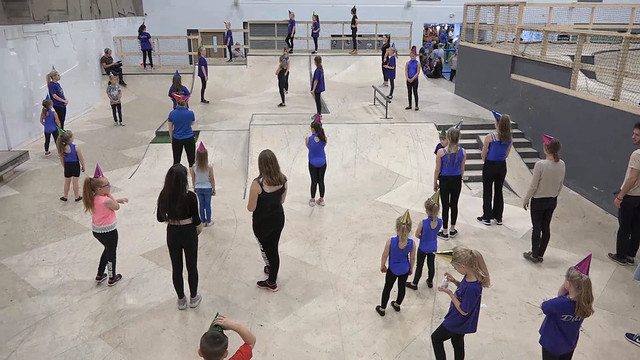The seed of what would eventually become GYM JAMS was planted in March 2016, with funding made available through Inspiring Healthy Lifestyles (formerly Wigan Leisure and Culture Trust), a social enterprise delivering services to Wigan Council. They had some money earmarked with the lofty aims of bringing art to Wigan, a borough of Greater Manchester with a predominantly sports-driven culture. I was not sure if the rebranding activity of the organisation was intended to bring about a behavioural change, or emphasis campaigning above open cultural programmes. Either way I found a supporter in Helen Seddon at IHL who understood the benefits of arts-based activities and who became an enthusiastic supporter of applying arts-informed activities to the work undertaken by her division within the council, and whose enthusiasm and championing became critical to the programme’s development.
With a higher-than-national-average level of deprivation, manifest in a 10-year lower life expectancy than the rest of the country, the newly refurbished Howe Bridge Leisure Centre faced pressure from an austerity-squeezed council to improve people’s health and generate revenue. Offering an indoor skate park, BMX bowl and climbing wall, as well as the usual high-spec gym equipment, spin room and dance studios, its location between Atherton and Leigh covered a catchment area with even harsher life outcome demographics than the rest of the borough. After a consultation programme with local youth skaters to design and implement the skate park, Helen could see the value and increased engagement that outward-facing arts activities could achieve, particularly with regards to providing return-on-investment for an already challenged budget. She approached Re-Dock with an open brief aimed at establishing similar levels of engagement, and realising increased ownership around the new IHL gym at Howe Bridge.

Mass dance in the soft play area from community dance groups of Ashton, Golbourne, and Hagfold.
The central question behind the brief from Helen was how do you bring culture to a community with little to no arts engagement? Re-Dock’s approach – long-term relationship building – conceals the complexity and hard work involved in realising it. Many arts and engagement programmes have taken a form focussed around individual artists and residencies, partly because the nature of funding and advertising attracts practitioners decoupled from the location where the activity takes place, and partly because known artists have an established programme and focus around their activities. Whilst well-intentioned, these artist-centred projects can often seem to involve parachuting in an outsider to deliver a short set of workshops or activities. After the programme ends, these often leave no legacy or on-the-ground impact with the very people they were intended to serve, failing to grow into the fabric of the locality’s life. At the worst end of the spectrum, they risk creating hostility and suspicion of the arts, with trust and participation abandoned once the funding runs out and the artist moves on, taking the processes and framework of the activity with them.

Tim and Chris handling OLO, the floating robot.
We took a collaborative approach, which incurs a tougher start-up programme, but aims to reconfigure relationships and strengthen community fabrics as a core part of the programme development. This involves an extensive programme of discovery and engagement, mapping out the range of local people and groups – not only traditional stakeholders but those who may be overlooked in traditional engagement programmes – and undertaking the legwork necessary to understand their needs and ways they could bene t from both a programme and interacting with other communities, taking a lead from their everyday activities and preferred environments.
Six months is not enough time to really embed ourselves in the community, but funded projects have deadlines and delivery dates. However, to overcome the risk of being another own-in programme, we put in place a steering group, composed of people grounded in the local community – members of IHL (from the education, engagement and well-being departments), and managers from local housing associations and the leisure centre. This ensured the programme would be informed by local needs and concerns, and develop trust and ownership for these nominated stakeholders and their communities; we set a five-month time frame to explore and identify needs within this phase of the project. Our aim was to centre the activities around grass roots needs, rather than deliver a top-down programme. To achieve this, we had to enthuse and excite this group sufficiently to want to promote it to their own networks, and to make them see it from their own perspectives and distinct needs; shared activities, non- traditional leisure, or just a different reason to visit a leisure centre that may challenge their preconceptions of what happens there. We listened to what these groups would tell us – both explicitly and implicitly – while explaining the broad objectives of the project, without being prescriptive with visuals or pre-de ned activities. Helen was a critical partner in this activity, providing the links and insights into the make-up of local communities, and identifying partners across Atherton and Leigh in Wigan.

Drumming and soundbeam workshop from Wigan’s More Than Words
Helen identified the potential reticence many stakeholders may have had working with an organisation like Re-Dock, who may associate an arts organisation with more traditional arts and crafts-driven engagement projects; she became critical to the successful delivery of the project as she understood the fluid and open nature of our delivery, and that negotiation and dialogue was as important a part of the programme as the final delivery of activities. Her understanding of our aims helped surmount the potential nervousness partners could have in working with new and non-prescriptive programming for the arts, and helped bring people on board as engaged partners, rather than participants following a path of least resistance.
Ultimately, it is the people that constitute a partnership, not their organisational entities. This may seem obvious at first glance, but when managing the needs of a wide range of groups, it was a message we had to keep reminding ourselves. Over the six months of activity, we found ourselves in a spectrum of situations to realise this ambition. To get to know the stakeholders, I had several coffee mornings in Atherton and Leigh (two areas keen to distinguish themselves from one another) and ran a Creative Practitioner Development workshop with Neil involving helium balloons in Howe Bridge. This brought into sharp focus the different agendas the various stakeholders were concentrating on – ranging from physical and mental well-being, education and healthy eating.
To work with the community, we ran a Doodlebot workshop during National Play Day in Wigan a month prior to GYM JAMS to get to know local groups with similar interests. The line up of activities during the actual day were a mixture of local talent and Re-Dock led projects. We wanted the people living in the area to perform; bring friends and family to create an event wider than we could on our own. GYM JAMS kicked off with free skate boarding lessons arranged by Howe Bridge, specifically targeting girls. Two mass dance performances performing in the unusual spaces of the leisure centre were made up of local groups. Two mass dance performances performed by local groups (Ashton, Golbourne, Hagfold) in the unusual spaces of the skate park and a soft play area, working together for the first time. We connected them with professional choreographer Malachi Simmons from Dance Manchester. Seasoned dancers Northern Starr performed in the skate park, this connection brought about by Emma Thompson, a member of the troupe and employee at Howe Bridge. We invited More Than Words, a Wigan based special needs advocacy group, to run drumming and sound beam workshops. We brought a cohort of artists from Wigan, Liverpool and Manchester to take part in the creative technologist activities, and sought out employees at Howe Bridge join us, as referees and furry mascots – all to bring together people to realise our overarching aim of unifying arts, culture and sports in an otherwise unassuming leisure centre in Wigan.

Doodlebot workshop during National Play Day
I don’t know how to measure the outcomes of this project. As noted by several people in this book, most of the tech fell over on the day, although most of the people didn’t realise that happened. I find it difficult to quantify engagement levels with community or stakeholders. So I’ll have to go on what Simon Byrom, the manager of Howe Bridge, said. He had gone from being sceptical of the process to realising, at the end of the days’ activities, that it had broken down traditional barriers and engaged people who [thought leisure centres were full of] all super- t people; he was keen to do another one. This was our measure of success; we knew that Simon could see the broader effect it had beyond the day of activities into reaching new people and changing how they thought about leisure centres, and opened them up to taking advantage of them. Later on GYM JAMS was a finalist in the Sporta Awards 2017 Community Impact through combined Culture and Leisure category. Even though it didn’t win, that recognition will make it easier to work with IHL and Wigan again. This is all part of the long-term relationship building process.

RoboGames Pixel Workout
Personally, I learned a lot by running GYM JAMS, and thought about best methods of sharing my experiences; could it be kiti-ed as a set of instructions? Would it be enough to document the process and events? Would this essay be the kit? I haven’t identified ed any approaches that don’t sound like easy-answer self-help book titles, so my answer is probably, I’m not sure.
This essay is published as part of Critical Kits and How We Use Them, a publication about DIY culture and how it meets participatory, inclusive and community-based forms of creative practice, following up from the Critical Kits Symposium (2016).